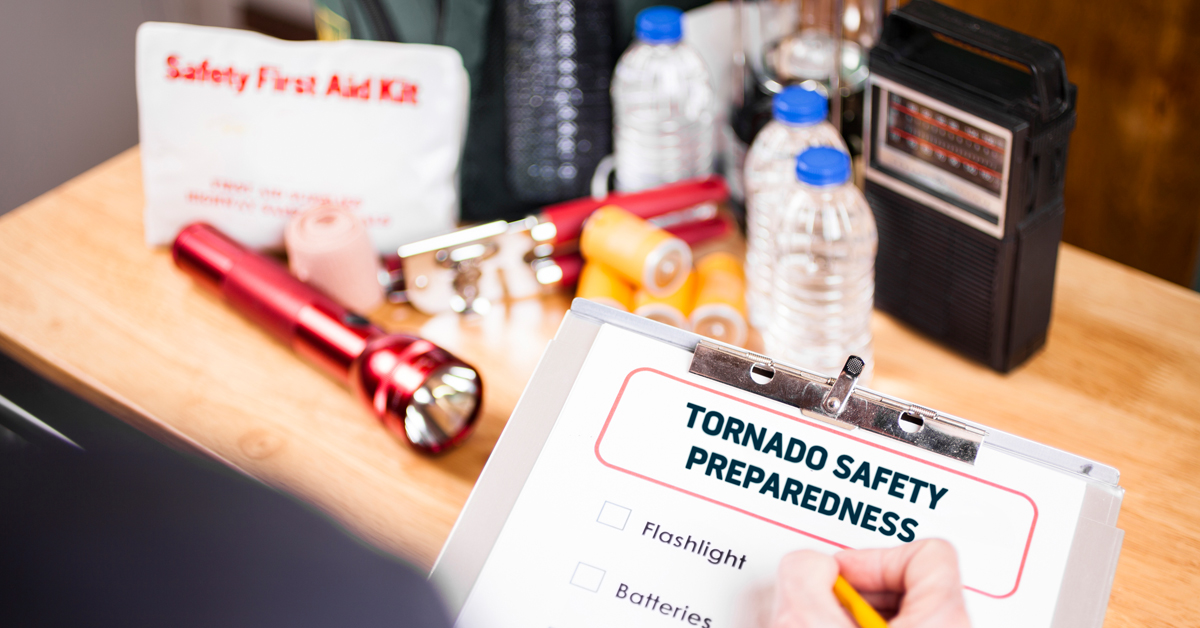CATEGORIES:
Tornado Preparation: Safety Before, During & After a Storm
March 4, 2024

Being home during a tornado threat is not for the faint of heart. The sky turns dark quickly, which can make your home's interior darker, even during the day. The wind picks up speed, and you may hear sounds you don’t normally hear: the rafters of your home creaking, branches scraping the house, the gusting of the wind itself, and the worried cries of your pet, who senses that something is coming. And these are all sounds that can happen when the tornado is just close, but doesn’t even touch down. Many tornado survivors talk about hearing what sounds like the loud roar of a freight train and feeling a sudden drop in atmospheric pressure that causes their ears to pop.
Tornadoes cause extensive damage and put lives at risk. But despite their volatility, there are steps we can take to prepare and protect ourselves and our loved ones. At Survive-A-Storm, we educate about the many ways to provide shelter during tornadoes, with our options for residential tornado shelters. But this blog post is intended to help with the knowledge and tools to equip your shelter and prepare to face tornadoes with confidence. By understanding what to do before, during, and after a tornado, and by learning tips for maintaining calm and resilience in the midst of chaos, we can significantly improve our chances of staying safe and minimizing the impact of tornadoes.
Essential Items for Your Shelter
Having a go-bag that comes with you into the shelter or is stored inside the shelter is next-level preparation for tornadoes. But, deciding what items are “essential” for your shelter is a balancing act. There are a few ways to organize a list of the items that are essential to have on hand. Most people will think about items that fall into four categories: safety needs, survival essentials, communications tools and comfort items. You balance your needs in each category with the space available. Here’s a list of suggested items to keep in a tornado shelter:
- Weather Radio - a quality weather radio will help you stay informed about the tornado's status and the condition of the local area, if a direct hit is taken.
- Flashlights and Batteries - a tornado is often accompanied by a power outage, so it’s a good idea to keep a flashlight and batteries. The flashlight on your phone will only get you so far.
- First Aid Kit - while a tornado shelter will keep you safe from direct injuries during the tornado, once you exit the shelter, you may be entering an environment with lots of hazards. Keep a first aid kit on hand for any minor injuries and to assist others.
- Water Bottles - staying hydrated is also a good idea, and during a storm, when stress is high, it’s key. Be sure to have drinking water - this will be a comfort if you decide to spend the evening in your shelter, and if the storm has affected the water supply, you might need it later.
- Non-Perishable Snacks - you likely won’t be in your tornado shelter for long, but it’s nice to have a few snack items as a comfort, or for emergencies. Granola bars, nuts and other dry goods are good additions to your storm kit.
- Sturdy Shoes - be sure that every person sheltering has a pair of sturdy shoes to protect their feet from debris when exiting the shelter. This is especially important if you’re accustomed to being in the house in bare feet and decide to quickly get into the shelter. Appropriate shoes should be either stored inside the shelter or in a go-bag that you bring in.
- Whistle or Horn - some people like to have a way to signal for help if needed.
- Blankets or Sleeping Bags - some families may decide to overnight in the shelter during a particularly bad storm system, or just to be safe. Blankets or sleeping bags for warmth and comfort are a great idea.
- Comfort Items for Children - it may seem non-essential, but having a few things to take the little one’s mind off the storm could end up saving your sanity. That might be a favorite stuffed animal, doll, or a portable electronic game. (If the latter, bring a charger or extra power supply too!) And, for infants, a supply of formula is also a good idea.
- Important Documents - keep a waterproof container in the shelter with your most important documents. This might include things like the deed to your home, tax information, insurance documents, birth and marriage certificates, medical documents, banking or other account information.
- Cell Phone with Chargers - be sure that the phones you bring with you into the shelter to communicate and receive updates have compatible chargers. If the storm has touched down and damaged the area around you, you might be spending considerable time on the phone and will need to recharge your devices. An extra power bank should be kept charged and ready to use in case of a power outage.
Creating a Disaster Supply Kit
The above list can go a long way to providing peace of mind and comfort. Some families opt for a “disaster supply kit” which is a more comprehensive collection of items prepared for various emergencies, not just tornadoes. It could include a broader range of supplies like food, water, first aid materials, personal hygiene items, tools, and more. This kit is meant to sustain a household for several days during any disaster so you’ll need to adjust the amount of water and non-perishable food items.
If that level of preparation is something you are interested in, the US government has created the ready.gov website. You can find excellent lists for starting your disaster supply kit, plus, a myriad of information about being ready, when to evacuate, brushing up on your safety skills and much more!
Preparation Steps: Before, During, and After a Tornado
Being prepared for a tornado doesn’t just mean shelter - though that is arguably the most important thing about tornado safety! Being prepared before, during, and after a tornado ensures your safety, minimizes the impact of the storm on your life and property, and enables a quicker, more organized recovery process.
Before the tornado
There are a few things you can do to prepare the area outside and around your home. For example, securing outdoor items. Tieing down, or bringing smaller inside items will prevent them from becoming projectiles in the high winds of a tornado. This includes items like outdoor furniture, grills, garden tools, trash cans, or sports equipment.
To reinforce your home and improve its resiliency during severe storms, consider installing storm shutters, impact-resistant windows and reinforced garage doors. If you’re in the market for a new roof, be sure to ask about using the strongest fasteners available to protect against high winds. Assess your property and the trees or other large items in the yard. Remove or trim branches that could fall on your home or those that are close enough to break windows. These measures can protect your home from the damage of tornadoes rated on the low side of the Enhanced Fujita Scale.
Create an evacuation plan so that your whole family knows what to do when a tornado warning is on for your area. Be sure every member of the family knows about the shelter and understands that it’s there for their protection. For those with young children, make a game out of going into the storm shelter at times when it’s not scary - a drill. This will prepare them for the real thing. Also, make yourself aware of your child’s emergency evacuation plans at school and make any accommodations necessary.
When the weather is bad, watch for local weather updates. Keep an eye out for tornado watches and warnings and know the difference. Teach your kids the difference, too, especially if they're at an age where they may be home alone. Practicing tornado drills can be a good way to prepare your children so that when a tornado is imminent, they won’t panic, but instead, will follow the safety plan. It’s also a good idea to subscribe to a location-based warning system that tells you exactly when your home is in the area that requires sheltering.
As mentioned, having shelter during tornado season (and all year!) is the most important thing. So, you first must identify where you will take shelter. Of course, as a supplier of NSSA-approved tornado shelters, we recommend getting to a tornado shelter. But, if you’re away from home, or don’t have one yet, you can seek shelter in the lowest level of a building, like a basement, or an interior room with no windows.
During the tornado
Once you’ve gotten to a safe place, it’s a bit of a waiting game. Staying calm is important, since that will help you think clearly. Take some deep breaths to reduce anxiety and keep your composure. If you are a parent, your calm demeanor will help your children stay calm. Reassure children that you are in the safest place you can be.
You should also stay informed with a weather radio or your smartphone for updates. Remaining in the shelter until you are sure the tornado has passed and authorities confirm it's safe to leave.
If you are away from your home tornado shelter, and seeking shelter in an interior room or basement, be sure to keep away from windows and exterior walls to avoid flying debris. You should also protect your head and neck with your arms, a heavy coat, or whatever is available.
After the tornado
Most times, the threat ends up being just that - a threat. You can come out of your shelter feeling good that you had a safe place to stay. You might need to call a few relatives to let them know you’re okay.
However, if a tornado does actually touch down while you’re in shelter, there are a few things to do.
- If you’ve sheltered in an interior room, rather than an NSSA-approved shelter like those from Survive-A-Storm, before anything else, check everyone for injuries, and provide first aid or seek medical attention, as needed.
- Before you leave your shelter, wait for the all-clear. If you subscribe to a service such as StormWarn and you’ve been told to seek shelter, you’ll receive an all-clear message when it’s safe to come out. You can also check your weather radio to make sure the threats have passed.
- Once you’ve exited the shelter, you can begin to inspect for damage. Carefully check your property for hazards like gas leaks or structural damage.
- Avoid downed power lines. Observe them from afar and report them to the authorities.
- Contact your family and friends to let them know you are safe. They may have heard about the storm and will appreciate knowing your status.
- Document the damage. For insurance purposes, take photos of any new damage to your property or home.
- If needed, use local resources for assistance and support, or offer your support to others.
Staying Calm and Safe in the Shelter
Staying calm during a tornado will help you think clearly and make better decisions in a stressful situation. It can also help those around you feel safer. Here are a few strategies to help you keep your composure during a storm:
- Practice deep, slow breaths to reduce anxiety and maintain composure.
- Focus on the present by concentrating on immediate actions and safety measures rather than thinking about all the "what ifs."
- Listening to weather updates can provide a sense of control.
- Reassure others. The act of comforting children or other family members can also calm your own nerves.
- Distraction is especially helpful for children. Engage in simple activities like playing a game or telling stories to divert attention from the storm.
Start Putting It All Together Now
As you’ve read, there are many facets to staying safe, but there’s one thing that is key to all of them - preparation. There’s no time like the present to start putting your essential items together now, planning a drill or, if you don’t have one yet, contact Survive-A-Storm about the best shelter to suit your needs!




